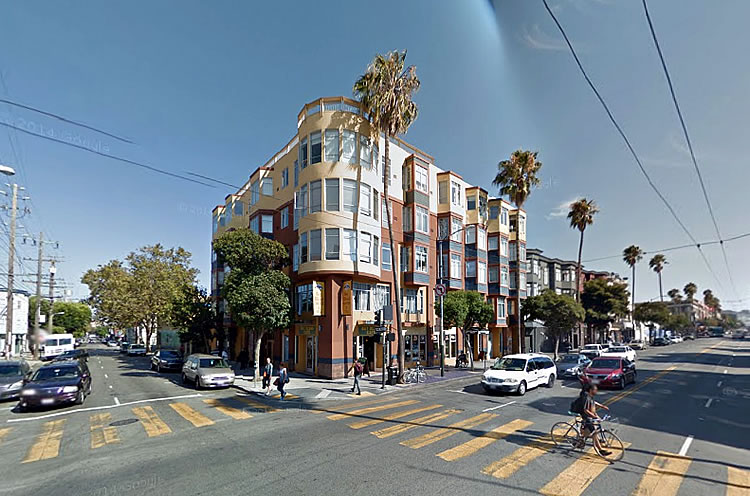Nine months ago the Below Market Rate (BMR) deeded two-bedroom condo #403 at 1587 15th Street, “located right in the heart of the vibrant Mission/Valencia corridor” above the former 4505/Belcampo Butcher Shop and featuring “a fantastic open concept floor plan with hardwood floors, a gourmet kitchen and its own assigned parking space,” was listed for $447,706, as set by the Mayor’s Office of Housing to be affordable to households earning up to 100 percent of the Area Median Income.
In order to qualify for the 724-square-foot condo, interested parties had to be a “first-time” buyers and income eligible, which in this case was $81,500 for a family of two (the minimum household size which could qualify) or $91,700 for a family of three.
And after nine months on the market with applications being accepted on a first-come, first-served basis, 1587 15th Street #403 sold for $410,000. The sellers had purchased the unit for $278,500 in 2007.




How does the Mayor’s office determine the pricing on resale? It’s disappointing that the house took 9 months to sell, and suggests the price should have been set lower from the outset.
See: Process for Reselling a BMR Unit.
In general, they’re repriced to remain affordable to the Adjusted Median Income band at which they were purchased, increased (or decreased) using the percentage change in the median income from the year of purchase to the year of resale.
To simplify things, it’s hard to fit certain requirements. The math is generally based off 100% AMI, which is around 73k for one person.
You NEED at least TWO qualifying people for the BMR program, which sets your MAX gross income to around 83k for TWO people. Children really become an advantage in the BMR program because they have 0 income, but count as additional people.
Then those two (or more) people have to be able to afford the 450k~ loan + downpayment. Your liquid assets will also need to be around 100k or you can get disqualified.
So looking at having around 100k liquid assets, you need to take a downpayment out of that, say 75k .. toss in all the fees related to closing and you got a big ass mortgage left over.
[Editor’s Note: You don’t need at least two people to qualify for the BMR program in general, but your household has to have at least as many people as bedrooms in the specific unit for which you’re applying (i.e., an individual can qualify for a studio or one-bedroom).]
just an fyi – the 4505 meats butchery closed, was briefly replaced by a belcampo butchery and now is on the market again.
[Editor’s Note: Good catch, since updated above.]
Do the sellers keep all the gain?
I think the city keeps most if not all of it. Which to me defeats the purpose of ownership.
That’s incorrect: Appreciation gained on a BMR unit upon resale belongs to the BMR owner minus all loans, closing costs, and any shared appreciation due from a City downpayment assistance loan.
Do you have a reference for that?
Also, the resale price is set by the city (in this case a fail). So unless poor people get richer, you ain’t gonna make a killing on any of these BMR’s. Which is only fair as its a subsidy. But then again takes away a major motivation of home ownership (at least in the Bay Area, where appreciation is a God given right.)
you still get the tax benefits though. and area median income (which is what the BMR sale prices are based on) has been rising.
Besides, I thought the purpose of home ownership was having a home
Renters also have a home.
yeah, BMR’s is just another trick to keep poor people poor.
It’s more difficult to sell, doesn’t rise in value, doesn’t subsidize your HOA dues. You may as well rent.
Looks like it rose by about $130k in value, or about 45%, since 2007. Assuming they didn’t use the down payment assistance, they made a decent little profit on the place. They might even be able to use that to make a down payment on a nonBMR unit outside the city.
Exactly. Combined that with likelihood they were able lower their effective income tax rate through the mortgage interest deduction, the owners of this unit – who bought the unit at a price that was SIGNIFICANTLY below market rate – have done quite ok for themselves. Its not like there was some magical alternative where they could have bought a two-bedroom condo unit is SF for $287k that wasn’t a resale restricted BMR. Their other options were (a) move far away from SF to either the Central Valley or buy a condo in a bad part of Oakland or Richmond, OR (b) continue to rent.
They got a GOOD deal for people in their socioeconomic level, and they did so via an indirect public subsidy, which in a way is paid for by all the other homebuyers on the market in a form of an indirect tax. This is the way public benefit programs are SUPPOSED to work: you earn below a certain level of income that the public deems deserves some form of subsidy, and in exchange, you receive some public benefit that is not resulting in you – the public benefit recipient – from receiving an undeserved windfall.
That this gives rise to such consternation among the Socketsite commentariat is more an illustration of the extremist IGMFY views of the commentariat than anything else.
IGMFY. LOL Awesome
Wow, this is shocking, I would have totally expected a huge bidding war to drive up the price of BMR’s.
Yes, let’s just stick with the easy snark and ignore the story that it took 9 months to find a qualified buyer for a two-bedroom BMR condo which was intended to be affordable to households earning up to 100 percent of the Area Median Income. And even then, the price had to be discounted 8 percent.
Maybe that’s why they are pushing to double the income limit, so people might actually buy them on the second go…
[Editor’s Note: The current push to double the income limits would only apply to rental units, not condos, as we first reported earlier this month.]
Yes, but your headline seems to be implying something other than the city miscalculated when determining how much condo their income limited buyers could afford. The fact that city employees did not know exactly how much loan individual buyers at various lower income limits could afford says extremely little.
Ie, wow, even a BMR can’t fetch its asking price, market must be softening…
“Fantastic open concept floor plan”
“Vibrant Mission/Valencia corridor” close to the heart of drugs, danger and homelessness at 16th & Mission.
Perhaps this is why it did not sell?
It did not sell because the requirements for the program are so minutely exacting that they don’t correspond with actual would be buyers. How are people not understanding that?
Exactly. I live in a condo that is part of the moh second loan program and absolutely no one that can qualify for the second loan program could actually afford to buy on of the units.
Anyone know how long the unit remains deed-restricted? The life of the building?
BMRs are for the life of the property
Not true. It depends. The most recently built ones have a lifetime constraint. But some have 50 years or 99 years, and some (Redevelopment Agency ones) can become market rate when the City encumbrance is taken out.
Thats right ohlone. There is a is mis-match between the 80,000 – 90,000 income and the 450,000 selling price — along with all the rules.
Fact that some developer produced this, forced to sell as a subsidy, and the City cannot even figure out how to make a market in units that sell for 50% of market is absurd.
Supes : Have a hearing on this the next time you have a hearing on why inclusonary should be raised to 40%
Can the City manage anything well?
There definitely seems to be a mismatch between the max allowable income and the original sale price.
I wish someone could answer the question of how this program deals with someone (likely self-employed) whose income fluctuates from year to year. Do they go back several years? average? use only the current or last years taxes? and then what if your income goes way up after you’ve moved in? is there an audit?
“All self-employed applicants must submit a notarized Self-Employed affidavit provided by MOH. If selfemployed for 2 or more years of federal income tax returns, MOH will average net income on the 2 years of tax returns. If self-employed less than 2 years of federal tax forms, MOH will annualize the submitted Profit & Loss statement.”
Agree something seems off between max income and sales asking price. Guess its why it took so long to sell.
I am surprised to hear the owner gets 100% of the appreciation minus costs. I’d assumed the City got a small percentage of the appreciation too. I would not have a problem with that if the money was put back into the BMR program in toto.
There are 6000 plus BMR units in the pipeline. if the Peskin 25% rule were in effect it would be around 18K. The Giants way exceeded 25% with their project so hopefully the 25% rule will work.
Personally I don’t begrudge this use of some of my tax money. I am a small time real estate investor and we get all sorts of tax breaks. Folks here know the litany.
IMO RE is the surest way for folk to accumulate wealth over time and bringing more people into home ownership is a great first step to maximize the advantages RE offers.
Yeah, that and Bush’s ownership society. That’s how we ended up with re collapse of 2008. I’m all for low income assistance, but If you want re as an investment, you should do it on your own dime, not my tax money.
But, but the Panama pares reveal “progressive” uber=wealthy Kerry has tax shielded accounts. They all do.
The bailout of the banks? Supported by Dems and the GOP. Crony capitalism.
The only way IMO that regular people can take advantage, to a degree, of the break the Bush’s and Kerry’s get is RE.
The big guys and gals will always have the advantage. Nothing new since Roman times to today. Human nature.
The ownership society started long before Bush and continues to this day.
The wealthy folk do it on our dime. It won’t change but rather than wail against the given, educate yourself to take adavantage of the given.
A regular Mom and pop person can buy a rental property in a solid market with a small doen. Postive cash flow that is totally shielded from any tax for 15 or so years given the front-loaded depreciation rules.
Your tax money and mine will always be les than the effective rate of the Bush’s and Kerry’s and Clinton’s.
It is what it is, but – educate yourself. RE is IMO the one vehicle the “regular” folk have to play the game.
Sorry again. Multi-tasking is not working for me today.
To correct my previous post –
The Panama “pares” should be the Panama “papers”.
“A regular Mom and pop person can buy a rental property in a solid market with a small doen” should be a “regular Mom and Pop person can buy a rental property in a solid market with a small down payment”.
You are going off tangent with lefty rant. The housing problem will not be solved by having the poor play the same game that brought us the problem at the first place. It’ll only benefit lucky few while making worse for the rest. Take this house for example. The $130k profit the seller made is money that could’ve been spent to house another family.
Leftie hatin’ on leftie. Love it
Much cheaper than renting, yet it took 9 mo. Besides the onerous qualification, I suspect even “poor” people are interested in appreciation potential, not just the cost, when they buy. Which begs the question: why bother with the complicated ownership program when the purpose is to assist low income folks with housing expenses? They should turn all bmrs into rentals.
Exactly. BMR should be all rentals.
The Giants can do a higher %age because they got a massive City subsidy in the form of deeply discounted land cost (to the detriment of the Port), and raised height limits. Actually, the Giants are not paying for the higher %age, you and I are paying for it. Likewise Forest City’s 5M project (raised height limits) and 160 Folsom (deeply discounted City land and raised height limit).
Peskin’s 25% will not work for smaller projects or for projects outside of the core or for project where the City does not do some kind of special deal. It will decrease housing production, not increase it.
None of us knows if the Peskin proposal will work. I think it will, but time will tell. I suspect it will pass and the subsequent developer response will tell it all. 25% seems reasonable to me. Something has to be done and developers are doing nada, IMO.
I have 7 or 8 techy guys renting rooms near me, a SFH hood, cause they can’t afford 3000K per month for an apartment. Newbies making around 100K so, after taxes, they really can’t afford a 3000/month apartment.
Of course they could continue to live as graduates from solid colleges with great degrees but as if they were still in college. Hence the migration to the Northwest from the Bay Area by young folks. And to other areas but Seattle and Portland are hot for millennials right now.
I don’t pretend to have the answer, but something has to give.
Must be two incomes to qualify? does this mean this BMR sale was closed to any single person if all other income and credit/qulaifyingcriteria were met? Seems wildly discriminiatory.
Is there an asset limit on BMR purchasers? These kind of properties might become very appealing to retired folks who are asset-rich and income-poor — especially if they have the assets to buy these for cash,
Yes – there is a formula to adjust your qualifying “income” number by the amount of your assets. I think you add 10% of the first $100k and 35% of the remaining assets to your actual income – that new number must qualify.
BMR does not use anyone’s tax dollars. BMR is solely paid by the developer and the developer may have to raise price on market rate housing. Basically, BMR is supported by higher price for market rate housing. It has nothing to do with your tax dollars.
This faulty logic gets repeated all the time here. Developers do not raise the price on market rate housing in order to make up for BMRs. Developers sell their market rate units for the absolute highest price they can obtain regardless of whether there are any BMRs involved. I.e. they do not give a “non-BMR discount” when there are no BMRs. And they do not (and cannot) “demand” a higher than market price when there are BMRs in the mix.*
Also, the BMR program does require a taxpayer-funded bureaucracy to manage the program. So it is largely accurate to say that the developers bear the BMR costs rather than the taxpayers, but not entirely.
* Yeah, I know, there is some miniscule impact on the market because of the smaller number of market rate units that are available because of BMRs. Go ahead and try to quantify that in a city of several hundred thousand housing units.
I favor eliminating the BMR “ownership” program. The BMR rental program makes more sense.
WHAT IS IGMFY?
Internet slang for I GOT MINE F**K YOU.
I’m surprised that BMI’s aren’t more popular with those who generate a significant amount of cash that is not reported to the IRS. One half of a couple could make a moderate $60K, the second person make a reported $0-20K but have an additional $50K in cash that could be used to make the down payment and have the asset requirements.
Cash-based operations: some retail store owners e.g. dry cleaner, drug dealers, some restaurant workers, house cleaners, many self-employed work for hire type folks, etc.
A lot of people were making comments about the “nine months on the market.” Although I don’t have personal experience with the process, it’s my understanding from talking to those that do, that the whole city application and approval process is VERY slow and it can add months to the process. So it wouldn’t surprise me if that unit was in escrow (or at least had offers pending) for months while they were vetted and the winning offer and applicant were approved.